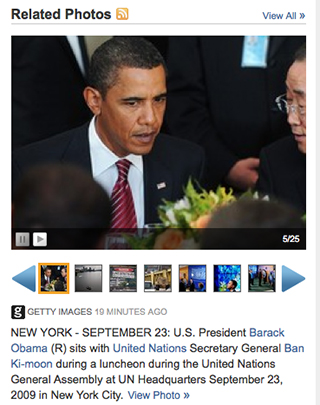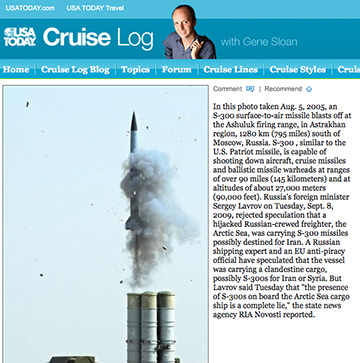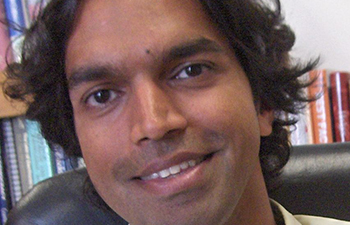
This is one in an occasional series on MediaShift where I discuss issues in-depth with thought leaders in online media. If you have suggestions for future Q&As or want to participate yourself, drop me a line via the Feedback Form.
Profile
Upendra Shardanand
Age: 37
Hometown and Current Location: Gaithersburg, Md.; New York
Online Persona: Personal blog; Twitter; Facebook
What Makes Him a Thought Leader: Shardanand is the CEO and founder of Daylife, which provides paid services to online publishers to help them aggregate and filter their own content or licensed content (including photos, video, stories and more). He was involved in collaborative filtering while at MIT in the mid-‘90s and co-founded Firefly Network, which was sold to Microsoft. While at Microsoft, he launched Microsoft Passport. He was a founding partner of The Accelerator Group venture capital firm, and was director of technology at Time Warner Corporate.
What He’s Doing Now: Shardanand recently re-focused Daylife from being both a platform and a destination website. The current strategy is to put the platform first and let Daylife.com fall further into the background. Recently, Getty Images invested $4 million in Daylife and announced a partnership with the company. Getty will sell Daylife services, including the SmartGalleries tool for showcasing photos online, to its clients. Getty joins previous Daylife investors the New York Times Co., Craigslist’s Craig Newmark and TechCrunch’s Michael Arrington.
Q&A
How has your vision for Daylife changed over the last two years since you’ve launched the site and service?
Upendra Shardanand: When we launched the business, the concept was to do a platform and a site that the platform powered. We launched in December ’07 with a client using the platform, and in January ’08 with the site, and pretty quickly our focus went to the platform. The concept is to help publishers easily and quickly curate, organize and aggregate media, whether it’s from their own archives, from around the web, or from other third-party providers. A lot of our publishers are not traditionally deep into technology, so we’re building the technology layer and editor tools so that the process is effortless and scales.
Our first big break came at the end of ’07 when we signed with USA Today. They called us and said they have a travel section with one blogger blogging about cruise lines. They were trying to sell sponsorships to Royal Caribbean and other cruise lines but they didn’t have enough traffic in this area. So they took Daylife and gave it to their editor and IT guys and built Daylife-powered pages with photo galleries and sections for every port of call and cruise operator. It went from being one editor and a skinny blog to being one editor plus Daylife, and it’s much more of a news portal. Traffic jumped by seven times within three weeks.
Until that point, we had focused on 100 percent automated solutions, where everything is automated. But with USA Today, the blogger Gene Sloan wanted a console where he can tweak things and move things around. That put us on a path to be much more around building tools that help people curate themselves along with automated assistance.
What about the tools you are building for Getty Images, now that they’ve become an investor in Daylife?
Shardanand: The Getty relationship is focused around distributing tools to their client base that revolve around the workflow of an editor. So they can do what they do but more efficiently, and with a lot more intelligence, and make their job easier and faster. The first thing we’re doing with Getty is called SmartGalleries [see demo, below]. The basic problem for any wire service is supplying assets to any publisher. With Getty, the assets are photos, and they just drop that at the publisher’s doorstep, and the publisher has to figure out how to ingest it, put it in their CMS [content management system], figure out a workflow, maximize user engagement.
So we built this tool so that people can quickly go in, build a gallery by searching and dragging things around, and make a player. It also has automated assistance where an editor can say ‘here’s one photograph, fill in the rest for me, based on what I’ve already picked.’ Once the gallery is published, the automation will keep it up to date, and can build related galleries. So if you have galleries around the U.S. Open, it will automatically generate galleries for Roger Federer or Serena Williams. An editor can launch a gallery, or an infinite web of galleries, which is great for the editor, because it’s an easy way to publish very quickly.
SmartGalleries – Gallery Creation Overview from Daylife on Vimeo.
As a result of that deal, do you feel like you’re putting more of your time and effort into photography?
Shardanand: We are in the short term because this is the first product of several we’ll be doing that [Getty] will be selling through their sales force. It uses a lot of the basic technology we already had with our platform, which can serve photography, video, text, Twitter, maps — a variety of things.
So Getty will sell this to their clients as a photo organizer and aggregator?
Shardanand: Yes. We’ll be selling it as well, but we have a sales force of two and they have 700, so hopefully they can sell more than we can. The cost varies depending on the size of the client. It could be anywhere from a couple thousand to several thousand dollars per month, depending on the scope of the content library.
And this is content that they own or have licensed? How does the intellectual property work?
Shardanand: If you have a license for Getty content, that will be part of the interface. If you have your own archives, that will also be part of the interface. And if you have a license for images from AP or Reuters, it will work with that as well, provided your license permits it. Today, our platform works with AP content, Reuters content, and Getty content, as long as you have a license for that, as well as your own content. So we will work with any photo provider as long as you have the rights to use the photography.

Tell me more about how you feature appropriate photos. I looked at the USA Today Cruise Log photo gallery, and there are cruise ship photos as well as cruise missiles and war shots that aren’t in context. How do you deal with that?
Shardanand: We have knobs and dials so the publisher can choose what they want. For the example you are talking about, what they should do is add in to their search terms, “- missile” so those don’t show up. It’s based on how the publisher sets it up. It works a couple different ways, either on key words that you pick, or from the metadata the wire service sends out. To the extent that they are looking for related photography, we’ll do our best to scan our page and find photographs that are related based on the text of the page. In those cases, the editor can tweak photographs, use it as a baseline or refine the filter further.
The thing with any automated solution is that it’s always going to be 85 percent to 90 percent of the way there, and a real editor — a human editor — has to go in to tweak it for better quality. The purpose is to help get the editor started and take out the initial work, and the editor can do the high-value tweaking in the middle. It’s about capturing what the editor’s intent is as easily as possible.
Hear Shardanand explain what kinds of subjects work well with Daylife aggregation, and how the service can save time for editors:
What were the difficulties in starting a destination site? What lessons did you learn about that?
Shardanand: Well we never did a whole lot on the site. The main business was the platform and the site was minimally a showcase of the platform. We had to build something ourselves to understand how all these thing worked.
If you go shopping at Amazon, you are looking at a book, but then you see links to many other things, background information, go to another book by that author — and the next thing you know, you’re looking at a pair of pants. It’s an infinite browsing experience with everything connected. The way news is published online is often the opposite and not at all “webby,” with no connection to anything else. Which is why there’s a problem with user engagement — every article is a dead end.
So our concept was very simple. What if we created a facility to connect every piece of news content to everything else. So if there’s a story about Obama and the Gaza Strip, someone can say in their subconscious mind, what happened on this two or three weeks ago? What did the op-eds say about this? Have there been any new developments? So you dive into one story and keep reading and browsing more. It’s a deep browsing experience, but to do that requires an editor to make these connections themselves, or to have a technology that surfaces all the options.
The idea was that if we put the technology out there, people will build smart things around it. We do the hard work of collecting all the data and media and doing the analysis. Then we have clients who use it very simply, and others have been more inventive and done more novel UIs [user interfaces].
Can you give me an example of one of those?
Shardanand: One example is Doodle Buzz. A developer [Brendan Dawes] for an ad agency in the UK built this. So you do a search, and then doodle to see results. You then can doodle on the screen with your mouse, and it will show you all the articles. And then you can doodle one of those, and it will show you an abstract with more topics. We did all the back end of the data. So we let people use their imagination to build ways to see that data.
Most of our publishers stick to their bread and butter. One thing the Washington Post did that was kind of fun . . . this was live during the elections. It’s called Issue Tracker. The data is a bit stale now, but it was built for the elections to track the candidates on various issues.
There’s been a lot of debates about aggregators, with publishers complaining about aggregators stealing their content and business. Where do you come down in that debate, or do you just try to avoid it?
Shardanand: We try to avoid it because in some ways we’re on both sides. We’re actually trying to help publishers become aggregators themselves. So the publishers who are worried about being aggregated by Google News, we help them get content themselves in a more aggregated way. So we’re at a point where the biggest brands are doing aggregation — the New York Times, USA Today, Washington Post. Once the biggest brands are doing it, the cat’s out of the bag.
The issues will go away over time. The real issue isn’t that people are linking to your pages. People want links. The real issue is that those links don’t drive a whole lot of traffic, and when people arrive at your page, the pages-per-visit are very low. So [with] traffic from Google News, you’ll probably see 1.1 pages viewed on average. I think as soon as publishers are better able to take those flat pages and make them a much deeper experience, then the problem goes away.
The fundamental problem is an issue of user experience, which is poor. And as a result, people don’t follow the links, and when they do, the publisher doesn’t get a whole lot out of it. So we’re trying to crack the puzzle of figuring out how to make those pages perform better. I can’t say we cracked it, but we’ve made progress toward it.
Why isn’t the New York Times a client?
Shardanand: The New York Times has a couple hundred ideas of their own. Most of our clients are short-staffed on the engineering side and the user experience side, and so they need to outsource some of this work to people like us. But the New York Times very wisely invested money early on to develop things in-house. We do a lot of cross-pollination with them, but fundamentally they build things themselves.
Has the recession been a plus for you, a minus, or both?
Shardanand: Both. Recessions in general are never good. In our case, we’re in the nascent space of content media services. It’s not exactly a saturated market, and it’s expanding. Even with the recession there’s room to grow, which is good. The other thing with the recession is it put pressure on the publishers to think hard about how to do more with less, so they will use services like ours to get more engagement from pages. That’s been good. That said, they do have less money. But we’re still growing. Q1 was better than Q4 last year, Q2 is better than Q1, Q3 will be better than Q2. So it’s hard to say whether it’s been a net good or net bad for us.
How close are you to being profitable?
Shardanand: It should be in the next three months, but after the Getty investment our product mix will change a little bit. But it will be in the next year, certainly. We have a major distributor to support, so that will add into the capital investment in the short term.
Hear about the technology and journalism background of the staffers at Daylife:
*****
What do you think about Daylife’s services? Will they continue to sell even if the market picks back up and publishers can aggregate data on their own? Share your thoughts in the comments below.
Mark Glaser is executive editor of MediaShift and Idea Lab. He also writes the bi-weekly OPA Intelligence Report email newsletter for the Online Publishers Association. He lives in San Francisco with his son Julian. You can follow him on Twitter @mediatwit.


The customized galleries from Getty seem really nice.
But if the cost is too high some may turn to less expensive solutions and deal with the extra hassle.